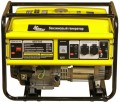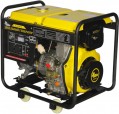Fuel
The type of fuel that the generator's engine runs on.
—
Gasoline. One of the main types of fuel for internal combustion engines. Gasoline generators are usually cheaper than diesel generators, all other things being equal, but they are more expensive to run due to the higher price of gasoline; in addition, they usually have a shorter resource than diesel ones. Therefore, it is believed that gasoline generators are well suited primarily as a backup power source in case of a power outage.
—
Diesel. Diesel generators are usually more expensive than their gasoline counterparts; on the other hand, diesel fuel is cheaper than gasoline, so the increased cost may well pay off with regular use. In addition, diesel generators have a longer resource and a larger power range than gasoline ones. This allows them to be used as both backup and main power sources, including at rather "energy-intensive" objects.
—
Gas. The advantages of gas-fired generators are relatively low noise levels and low emissions. On the other hand, the use of gas as a fuel is associated with certain difficulties: it is necessary to connect to a gas pipeline or regularly replace special cylinders, the fuel system is especially sensitive to leaks, etc. Therefore, there are relatively few such models produced, and most of them are stationary high power generators, in which the mentioned disa
...dvantages are covered by the advantages.
- Gasoline / gas. Models capable of using both types of fuel indicated. This gives the user the opportunity to choose the option that best suits a particular situation, and also reduces the likelihood of being left without fuel at the most inopportune moment; on the other hand, such models are more expensive than single-fuel ones. The technical features of gasoline and gas are described in detail above.Engine size
The working volume of the engine in a gasoline or diesel generator (see "Fuel"). Theoretically, more volume usually means more power, but in fact, everything is not so clear. Firstly, the specific power strongly depends on the type of fuel, and in gasoline units, also on the type of internal combustion engine (see above). Secondly, similar engines of the same power can have different volumes, and there is a practical point here: with the same power, a larger engine consumes more fuel, but by itself it can cost less.
Power
The operating power of the engine installed in the generator. Traditionally stated in horsepower; 1 HP approximately equal to 735 watts.
First of all, the rated power of the generator directly depends on this indicator (see above): in principle, it cannot be higher than the engine power, moreover, part of the engine power is spent on heat, friction and other losses. And the smaller the difference between these capacities, the higher the efficiency of the generator and the more economical it is. However high efficiency affects the cost, but this difference can pay off with regular use due to fuel savings.
Starter type
Method of starting the electric generator engine. To start the internal combustion engine (petrol or diesel, see "Fuel"), it is necessary to turn the engine shaft in any case; this can be done in two ways:
—
Manual. With this method of starting, the initial impulse is transmitted to the engine manually - usually the user needs to pull hard on the cable that spins a special flywheel. The simplest in design and cheapest method of starting, from additional equipment it requires only the cable itself with a flywheel. On the other hand, it may require the user to apply significant muscular effort and is poorly suited for high-power units.
—
Electric starter. With this type of start, the engine shaft is rotated by a special electric motor, which is called a starter; the starter is powered by its own battery. This option for starting the generator power unit is the easiest for the user and requires a minimum of effort. Depending on the implementation of the electric starter, it is usually enough to turn the key in the ignition switch, press a button, turn the handle or rotate a special drum, etc. The power of modern starters is sufficient even for heavy engines, where manual starting is difficult or impossible. Also note that an electric starter is required by definition to use the ATS autostart (see "Features"). On the other hand, additional equipment affects the weight and cost of the unit,
...and sometimes quite noticeably. Therefore, such starting systems are used mainly where they cannot be avoided - in the aforementioned heavy equipment, as well as generators with ATS.Fuel consumption (50% load)
Fuel consumption of a petrol or diesel generator when operating at half power, and for combined models when using petrol (see “Fuel”).
Fuel consumption usually increases with load. However, generator efficiency is not always linear - fuel consumption may vary disproportionately with different loads. In this case, the approximate amount of fuel consumed by the generator when operating at half power (50% of the rated power) is given. Knowing the fuel consumption and tank capacity, you can at least estimate how long one fill-up will last.
Fuel tank volume
The volume of the fuel tank installed in the generator.
Knowing the fuel consumption (see above) and the capacity of the tank, you can calculate the operating time on one gas station (if it is not indicated in the specifications). However, a more capacious tank is also more bulky. Therefore, manufacturers choose tanks based on the general level and "voracity" of the generator — in order to provide an acceptable operating time without a significant increase in size and weight. So in general, this parameter is more of a reference than practically significant.
As for the numbers, in low-power models, tanks are installed for
5 – 10 liters, or even
less ; in heavy professional equipment, this figure can
exceed 50 liters.
Output 12 V
Existence in the generator of an
output with a direct current and voltage of 12 V. The main function of this output is to charge car batteries, as well as power devices originally intended for cars (recall, 12 V is the standard voltage of on-board networks in cars).
The following types of 12-volt outputs are found in generators:
- Terminals. Terminals are used to connect wires directly without using any plugs. This connection is the most reliable.
- Socket. Socket outlet for a plug with two flat pins, designed to connect 12-volt consumers. Holes in sockets come in different layouts, which you need to pay attention to.
- Cigarette lighter. The so-called "car socket", which in many cars is combined with a cigarette lighter socket (hence the name). Such connectors are used to power various automotive devices and accessories.
Wheels
The electric generator has
wheels for moving from place to place. Most often, the design provides for a pair of wheels and a pair of parking supports: during working hours, the supports play the role of brakes, and when moving, they need to be raised above the ground and the generator rolled on two wheels; however, there are models on 4 wheels. Anyway, this feature greatly simplifies transportation: it is much easier to roll the unit than to carry it on weight. This is especially true in light of the fact that the weight of a modern generator can exceed 100 kg: several people will be needed to carry such a weight, while wheels often make it possible to manage by one person.
Noise level
The noise level produced by the generator when operating in normal mode. The less noise the unit makes, the more comfortable it is to use, the closer it can be placed to people, but the higher its price, all other things being equal.
It is also worth considering that generators with internal combustion engines are, in principle, quite noisy equipment. Thus, even the "quietest" units produce
< 70 dB - this is the volume of a conversation in tones from medium to high. Accordingly, it is recommended to install the device remotely from the place of use. At the same time, we note that the noise level is not directly related to the power: for example, among units of 80 dB and more, there are both heavy and relatively low-power models.

